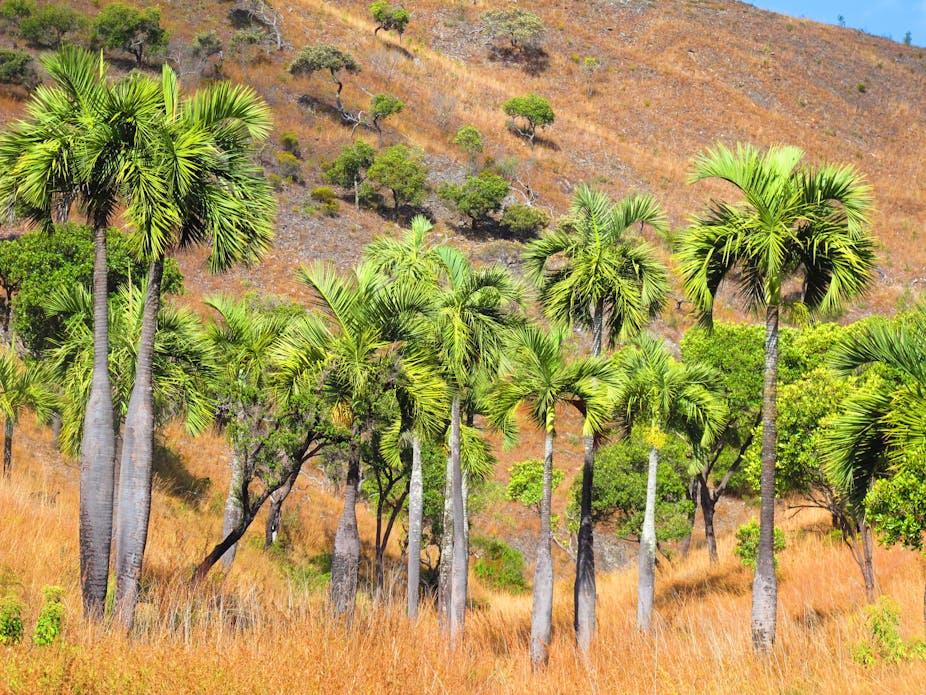Madagascar is a crucial diversity hot spot for palm tree species. 98% of the currently 204 known species do not occur anywhere else.
This high diversity is because the island – and its palms – had a long period of isolation following the break up of the ancient super continent of Gondwana. The humid northeastern forests of Madagascar have the richest species diversity, there can be up to 45 different palm species in one square kilometre.
Unfortunately, their uniqueness and prominence throughout Madagascar’s ecosystems have turned them into one of the most used and exploited plants on the island. Palms have multiple uses including; thatching, construction, for basket weaving, food and even medicine.
Threats to the palm
The situation is so severe that the latest IUCN redlist of threatened species estimated that 83% of the native species are threatened and on the verge of extinction. In the case of the Tahina spectabilis, for example, only 30 mature individuals are known to exist in the wild. It’s a particularly vulnerable species as, though it can live up to 50 years, each individual can produce flowers only once.
Palms are vital to rural people whose daily subsistence depends heavily on natural resources. They use palms to build their housing, for daily tools – such as brooms, strings or knife sleeves – and they also eat the palm heart. The palm is also valued by rural communities for its medicinal properties which can be used to treat coughs or digestion problems. Unfortunately, many of these uses are lethal to the palm trees. For instance, extracting the palm heart kills the tree.
Another threat is the introduction and success of Madagascar’s palms in horticulture. It started during botanical explorations of the island but, because of their ornamental value, the harvesting of palms for the international market has really exploded over the last 30 years. This has resulted in a huge amount of seeds being extracted from the natural habitat.
Unfortunately, seed harvesting is not always done in a sustainable way. Many collectors cut the palm trunk, killing the palm, for the whole head of fruit. Today, most of Madagascar’s palm species are sold in international markets and most of the seeds still come from the wild.
The high demand for the palms also mean that too many seeds are being exported. Collectors will often take most of the available fruits without a thought about the natural regeneration of the species. For example, few mature trees of Beccariophoenix madagascariensis now exist in its traditional areas – Mantadia and Fort-Dauphin. Or the majestic palm, Ravenea rivularis, this has seen a decline in its population because of its international popularity and seed harvesting.
And their regeneration is crucial. Palms are also victims of the massive deforestation that has plagued Madagascar since the end of the 19th century. The country has lost about 80% of its original forests.
Palms are slow growth plants. They’re ability to reach maturity often depends on the opportunity to reach the light after a gap in the canopy becomes available from the death of another tree. Therefore, the loss of mature palm trees constitutes an irreversible act for the population.
And when they are taken, it’s hard to keep them alive. Seedlings will rarely survive in disturbed or secondary habitats. In fact, 90% of Madagascar’s palms are restricted to humid forests and the change of the ecological niches from this primary vegetation type dramatically reduces their survival rate.
Their loss would be devastating as palms play a vital ecological role in Madagascar’s ecosystems. The loss of several species will undoubtedly have a huge negative impact on both the fauna and flora of the island. Their fruits are eaten by many animals, their leaves and crown are often used as nests for birds, insects, reptiles or amphibians. Studies for example show that the black lemur spend big parts of their feeding time eating fruits of the Dypsis madagascariensis when these are available. This illustrates how the absence of a particular palm species could lead to the extinction of animals dependent on it – whether due to the loss of adequate food, shelter or breeding habitat.
What must be done
To save this natural legacy, as stated by the IUCN, an action plan needs to be urgently set up. Conservation efforts must include local communities in the activities and be focused on raising awareness and increasing the species survival rate. For example, more research and projects need to look at how to improve the germination rate of seeds and how local knowledge can be integrated for their sustainable management.
Compared to other charismatic plants, such as orchids, research on palms has made remarkable progress in the last two decades. Nevertheless, expeditions in under-explored sites often reveal new groups emphasising the need to continue taxonomic – classification – investigations. Since the publication of the book Palms of Madagascar in 1995, about 34 new species have been discovered, these include a completely new genus (Tahina) discovered in 2007.
Creating a solid botanical inventory of the palm will become an even bigger challenge with the huge natural ecosystem loss facing the island today.


